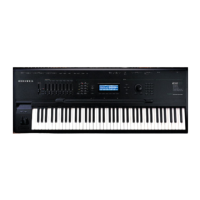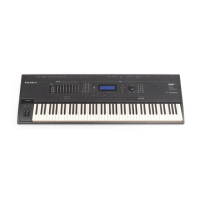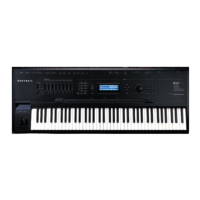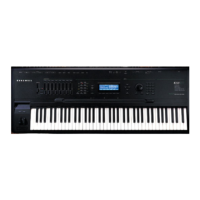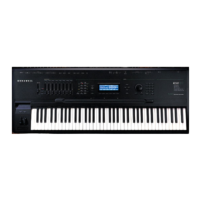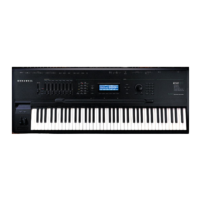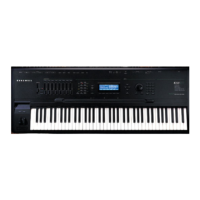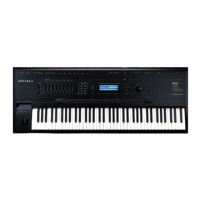DSP Functions
Waveforms Combined with Non-linear Functions
14-49
discontinuities from the wraparound. The resulting signal has a large DC offset, so a constant of
3/8 is subtracted.
The parameters on the control input page for SW+DST control the pitch of the sawtooth wave.
Added Sawtooth Wave Plus SHAPER (SW+SHP)
For this function, the sample input is combined with a sawtooth wave, then passed into the
SHAPER function. The SHAPER has a constant Adjust value of .25. First, the sample input is
multiplied by a constant, which may cause it to clip. Any clipping becomes part of the signal.
This result is added to the sawtooth wave, which may cause the waveform to exceed full scale.
If it does, the signal wraps around as in the WRAP function. This result is then put through the
SHAPER.
You may want to use the Pad parameter with this function, depending on the sample you use.
Pastorius fans should try this function using one of the Electric Bass keymaps. Use Algorithm 8,
and start with the second and third algorithm blocks set to NONE. Set the fourth block to
SW+SHP. Try setting the Keymap transposition to -12, and the SW+SHP key tracking to 100
cents per key.
Shape-modulated Oscillator (SHAPE MOD OSC)
This function combines the sample input with a sine wave at 1/4 scale, does a combination of
additions and multiplications on both signals, then puts the result through a SHAPER function.
The amount of shaping depends on the levels of both the input signals. First, the SINE value is
multiplied by the sample input value, then multiplied by a constant—any samples exceeding
full scale will wrap around. The result is added to the wrapped product of the SINE value times
a constant. The entire resulting waveform is then passed through the SHAPER, whose Adjust
value is set by the level of the sample input. You might think of this function as an oscillator
whose shape is controlled by the sample input signal.
Even if the depth value goes to zero, there will still be a non-zero final output, due to the
addition of the multiplied SINE value. In this case, the output would be a slightly distorted sine
wave. As the value of depth increases, the harmonic content of the output signal will rise,
assuming the pitches of the sample input and the sine wave are simply related—unison,
octaves, etc. Slight detuning between the two pitches will cause a slow beat frequency.
The parameters on the F2 PCH control input page affect the pitch of the sine wave. Those on
the F3 DEP page affect the level of the sample input, and consequently the amount of SHAPER
that’s applied. If the DEPTH values exceed +5 dB, then the product of SAMPLE INPUT x
DEPTH may clip, adding further harmonics through a mechanism that differs from the
addition of harmonics below the +5 dB DEPTH level.
x SHAPE MOD OSC
Available only in Algorithm 18, this function is similar to SHAPE MOD OSC, except that it
multiplies its two input signals and uses that result as its input.
+ SHAPE MOD OSC
Also available only in Algorithm 18, + SHAPE MOD OSC is similar to x SHAPE MOD OSC,
except that it adds its two input signals and uses that sum as its input. With this and all the
modulated oscillators, let your ears be your guide.
Amp Modulated Oscillator / Final Amp (AMP MOD OSC)
This function is available only in Algorithm 17. The sample input is multiplied by the output of
a sine wave oscillator. This result is scaled by the parameters on the F3 DEP control input page,
and the result is added to the original sample input and sent to the final AMP function. The
parameters on the F2 PCH control input page affect the pitch of the sine wave, and
consequently all subsequent results.

